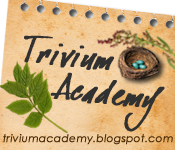I have all of our science books in groups on our unused formal dining room table and I've been racking my brain on how to effectively organize them. I was lost on how to organize our books about animals until someone (thank you Dawn, you've been very inspirational!) pointed out that they could be organized by taxonomy. Taxonomy is the process of classifying living things by Kingdom, Phylum, Class, Order, Family, Genus, Species (it goes further and into sub-categories).
Looking at our books, we have books based on ecology or ecosystems (habitats) which focus more on an individual habitat and discuss the various animals which inhabit it. Then we have a few (just a few) books on individual or similar animals and animal behavior.
I need organization, it is something I crave and once I have it, I can move more freely through our studies with a focus instead of feeling all over the place. Because there is a HIGH probability that we're moving, I feel like I should organize our books before packing them and science is the one area where I'm lacking a meaningful system. I've had them divided by Life Science, Earth Science, Physical and Chemistry but that's not enough. I still wasn't able to determine how many books we had in each field of science and which ones I wanted to use for any given topic without spending a good amount of time looking through the bookshelves.
My overall divisions for our science books are as follows:
GENERAL SCIENCE
- Books that consist of more than one field of study (Biology, Geology, Astronomy, etc.)
- Reference books such as Encyclopedias that cover more than one field of study.
ASTRONOMY
: the study of objects and matter outside the earth's atmosphere and of their physical and chemical properties- Books about Space, Space Travel and celestial objects.
The scientific study of celestial objects (such as stars, planets, comets, and galaxies) and phenomena that originate outside the Earth's atmosphere (such as the cosmic background radiation). It is concerned with the evolution, physics, chemistry, meteorology, and motion of celestial objects, as well as the formation and development of the universe
METEOROLOGY
Scientific study of atmospheric phenomena, particularly of the troposphere and lower stratosphere
Meteorology entails the systematic study of weather and its causes, and provides the basis for weather forecasting. See also climatology.
: a science that deals with the history of the earth and its life especially as recorded in rocks- Books that deal solely with the physical properties of Earth
: a study of the solid matter of a celestial body (as the moon)
Basic Concepts: rocks, soil, and gemstones, geology studies the composition, structure, physical properties, history, and the processes that shape Earth's components
PALEONTOLOGY
the study of prehistoric life forms on Earth through the examination of plant and animal fossils. This includes the study of body fossils, tracks (ichnites), burrows, cast-off parts, fossilised faeces (coprolites), palynomorphs and chemical residues. Studies of prehistoric hominins, their culture and their behaviour are the purview of two other disciplines, archaeology and paleoanthropology.
Basic Concepts: Prehistoric life, dinosaurs, fossils
- Books about Dinosaurs, Fossils, Prehistoric
OCEANOGRAPHY
- Books that deal with any study of the oceans, seas and large bodies of water on the planet Earth.Study of the Earth's oceans and seas. Covering a wide range of topics: marine organisms and ecosystem dynamics; ocean currents, waves, and geophysical fluid dynamics; plate tectonics and the geology of the sea floor; and fluxes of various chemical substances and physical properties within the ocean and across its boundaries.Concepts:
• Biological oceanography, or marine biology, is the study of the plants, animals and microbes (biota) of the oceans and their ecological interaction;
• Chemical oceanography, or marine chemistry, is the study of the chemistry of the ocean and its chemical interaction with the atmosphere;
• Geological oceanography, or marine geology, is the study of the geology of the ocean floor including plate tectonics;
• Physical oceanography, or marine physics, studies the ocean's physical attributes including temperature-salinity structure, mixing, waves, internal waves, tides and currents. Of particular interest is the behavior of sound (acoustical oceanography), light (optical oceanography) and radio waves in the ocean.
CHEMISTRY
: a science that deals with the composition, structure, and properties of substances and with the transformations that they undergo- Books that deal solely with the basic concepts listed above.
Basic Concepts: Atom, Element, Compound, Substance, Molecule, Mole, Ions and salts, Phase, Chemical bond, Chemical reaction, Energy, and Chemical laws
PHYSICS & OPTICS
- Books that deal solely with the basic concepts listed above.1: a science that deals with matter and energy and their interactionsBasic Concepts: force, energy, mass, and charge
2 a: the physical processes and phenomena of a particular system b: the physical properties and composition of something
TECHNOLOGY
: the technology involving the development, maintenance, and use of computer systems, software, and networks for the processing and distribution of data- Books that deal solely with the field of study defined above.
SCIENTISTS & INVENTORS
People in the past and present which make significant contributions to any of the fields of science.
*books will also be listed under each field of science as well
HUMAN ANATOMY
- Books that deal with the human body and biology in all aspects.Anatomy is subdivided into gross anatomy and microscopic anatomy.Basic Concepts: The human body consists of biological systems, that consist of organs, that consist of tissues, that consist of cells and connective tissue.
Gross anatomy (also called topographical anatomy, regional anatomy, or anthropotomy) is the study of anatomical structures that can be seen by unaided vision.
Microscopic anatomy is the study of minute anatomical structures assisted with microscopes, which includes histology (the study of the organization of tissues), and cytology (the study of cells).
Anatomy, physiology (the study of function) and biochemistry (the study of the chemistry of living structures) are complementary basic medical sciences where are typically studied in tandem.
ECOLOGY
1: a branch of science concerned with the interrelationship of organisms and their environments- Books that deal with habitats/ecosystems, environmental issues and endangered animals.
2: the totality or pattern of relations between organisms and their environment
Ecosystems: This classification is used to define the Global 200 list of ecoregions identified by the World Wildlife Fund (WWF) as priorities for conservation.This classification gives the following terrestrial biomes :
However, for our purposes we will arrange the ecosystems this way for our studies K-4:
- Tundra (arctic, humid)
- Boreal forests/taiga (subarctic, humid)
- Temperate coniferous forests (temperate cold, humid to semi-humid)
- Temperate broadleaf and mixed forests (temperate, humid)
- Temperate grasslands, savannas, and shrublands (temperate, semi-arid)
- Mediterranean forests, woodlands, and shrub (temperate warm, semi-humid to semi-arid with winter rainfall)
- Tropical and subtropical coniferous forests (tropical and subtropical, semi-humid)
- Tropical and subtropical moist broadleaf forests (tropical and subtropical, humid)
- Tropical and subtropical dry broadleaf forests (tropical and subtropical, semi-humid)
- Tropical and subtropical grasslands, savannas, and shrublands (tropical and subtropical, semi-arid)
- Deserts and xeric shrublands (temperate to tropical, arid)
- Mangrove (subtropical and tropical, salt and brackish water inundated)
Flooded grasslands and savannas (temperate to tropical, fresh water inundated)- Montane grasslands and shrublands (temperate to tropical, high altitude)
A. Grassland
1. Savanna
2. Prairie
3. Alpine (Mountain)
B. Desert
1. Coastal Desert
2. Semi-Arrid Desert
3. Hot & Dry Desert
C. Tropical Forest
1. Rain Forest
2. Sub-tropical areas
D. Forests & Woodlands
E. Aquatic
1. Freshwater
2. Ocean: Coral, Deep Sea
3. Wetlands, Rivers and Marsh
4. Arctic, Antarctic (Polar)
ZOOLOGY
1: a branch of biology concerned with the classification and the properties and vital phenomena of animals
2 a: animal life (as of a region) : fauna b: the properties and vital phenomena exhibited by an animal, animal type, or group
A. Taxonomy: orderly classification of plants and animals according to their presumed natural relationships
*This may change as I learn more but here's the structure I currently have and I do not claim this to be 100% accurate or finished.VERTEBRATES
KINGDOM MAMMALIA - MAMMALS
-Monotremes - platypus
-Marsupial - kangaroos, koala
-Insectivores - moles, hedgehogs
-Chiroptera - bats
-Primates - monkeys, apes
-Endentata - anteaters, sloths, armadillos
-Rodents - rats, mice, muskrats, voles, hamsters, guinea pigs, chincillas
-Carnivora
A. Dogs (wolves, foxes)
B. Bears
C. Racoons
D. Weasels, Otters, Skunks, Badgers
E. Hyena
F. Cats (Tiger, Mountain Lion, Puma, Cheetah)
-Proboscidae - elephants
-Perissodactyla
A. Horses
B. Zebras
C. Donkeys
D. Tapis
E. Rhinoceroses
-Artiodactyla
A. Pigs
B. Hippopatumus
C. Camels
D. Deer
E. Giraffes
F. Cattle, Sheep, Goats
G. Antelopes
-Pinnipeds
A. Walrus, Seal, Whales, Dolphins, Manatees
Microorganisms, Fungi, etc.
FISH
AMPHIBIANS
REPTILES
BIRDS
- Books the singly deal with these topics or groups
INVERTEBRATES- Books the singly deal with these topics
PORIFERA- SPONGES
CNIDARIA -corals, jellyfish, hydra and sea anemones
ENCHINODERMS -Sea stars, sand dollars
WORMS
MOLLUSKS
ARTHROPODS
- Pillbugs, Centipedes, Scorpions
- Spiders
- Insects
A. General Insects
B. Butterflies & Moths
C. Bees & Wasps
D. Ants
E. Cockroaches, Grasshoppers, Crickets
F. Beetles
G. Flies, Termites, Dragonflies
- Books the singly deal with these topics or groups
B. Traits and Behaviors: biological clock, dominance, estivation, growth, hibernation, instinct, metamorphosis, migration, mimicry, pheromone, camouflage, reproduction, sleep, sound, and territorial behavior
BOTANY
1: a branch of biology dealing with plant life
2 a: plant life b: the properties and life phenomena exhibited by a plant, plant type, or plant group
Botany covers a wide range of scientific disciplines that study plants, algae, and fungi including: structure, growth, reproduction, metabolism, development, diseases, and chemical properties and evolutionary relationships between the different groups. The study of plants and botany began with tribal lore, used to identify edible, medicinal and poisonous plants, making botany one of the oldest sciences.
I. Botanic Taxonomy
A. NONVASCULAR
Lack xylem and phloem tissues that carry water and food from one part of the plant body to another
1. BRYOPHYTA
Liverworts, hornworts, mosses
A. Hepaticae: Liverworts
B. Anthocerotae: Hornworts
C. Musci: Moses
B. VASCULAR
A. Psilophyta: whisk ferns or fork fernsII. Parts of plants: bark, bud, bulb, catkin, cell, cellulose, chlorophyll, chloroplast, corm, cotyledon, drupe, flower, fruit, grain, inflorescence, leaf, lenticel, nut, raceme, rhizome, root, sap, seed, spore, stem, thorn, tuber, wood
B. Lycophyta: Club mosses, quillworts, selaginellas
C. Sphenophyta: horsetails
D. Pterophyta: ferns
E. Coniferophyta: conifers, evergreen trees or shrubs
F. Cycadophyta: Cycads, fernlike leave and large seed cones
G. Ginkgophyta: Ginkgoes
H. Gnetophyta: found in deserts and tropical forest, seeds not in cones, leaves called bracts
I. Anthophyta: Flowering plants, angiosperms (two types of angiosperms: Monocotyledonae and Dicotyledonae
1. Monocotyledonae: One cotyledon
2. Dicotyledonae: Two cotyledons
III. Kinds of Plants: angiosperm, annual, biennial, bryophyte, carnivorous plant, conifer, dicotyledon, epiphyte, fern, flower, grass, gymnosperm, herb, hornwort, legume, liverwort, monocotyledon, moss, perennial, poisonous plant, pteridophyte, shrub, succulent, tree, vegetable, vine, water plant, weed
IV. Plant Products: Alcohol, Charcoal, Cork, Drug(s), Dye, Fiber, Food, Forest Products, Gutta-percha, Lumber, Paper, Perfume, Resin, Rosin, Rubber, Tar and Turpentine
V. Plant Growing: Agriculture, Alternation of generations, Auxin, Bonsai, Breeding, Farm & Farming, Fertilizer, Gardening, Germination, Grafting, Greenhouse, Herbarium, Hybrid, Hydroponic, Insecticide, Nursery, Photoperiodism, Photosynthesis, Pollen, Pruning, Reproduction, Soil, Terrarium, Transplanting
VI. Where Plants Live: Bog, Desert, Forest, Grassland, Pampa, Plain, Pond, Prairie, Savanna, Seashore, Steppe, Tropical Rain Forest, Tundra, Wetland
VII. Crops
VIII. Garden Flowers
IX. Wild Flowers
X. Herbs
XI. Vegetables
XII. Shrubs
XIII. Trees
For book purposes we will have all books about flowers, plants and agriculture under Botany.
I will be expanding this as we learn more about Botanic Taxonomy.
Special note: Creation vs. Evolution and all that jazz will be studied separately under Apologetics.




























1 comment:
Jessica-
I have much the same orgainization scheme for our science books. I did add one further catagory-experiment books. I have several of Janice VanCleeve's 201 things books and they seemed to beg their own catagory.
Thanks for all your posts-your organization is also inspiring!
Jenny
"Jumped Into The Deep End First"
Post a Comment